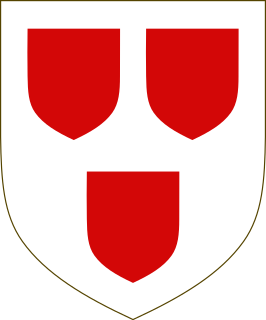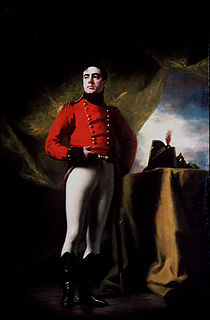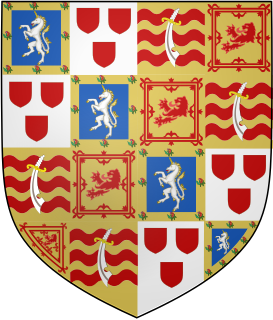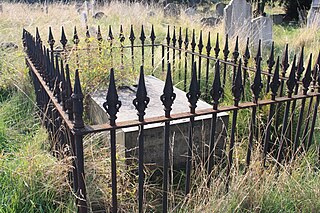Lord Hay may refer to:
- Earl of Erroll, a title in the Peerage of Scotland
- Marquess of Tweeddale, a title of the Peerage of Scotland
- James Hay, Lord Hay, British Army officer
- Willie Hay, Baron Hay of Ballyore (born 1950), Northern Irish politician
Lord Hay may refer to:

Duke of Hamilton is a title in the Peerage of Scotland, created in April 1643. It is the senior dukedom in that Peerage, and as such its holder is the Premier Peer of Scotland, as well as being head of both the House of Hamilton and the House of Douglas. The title, the town of Hamilton in Lanarkshire, and many places around the world are named after members of the Hamilton family. The ducal family's surname, originally "Hamilton", is now "Douglas-Hamilton". Since 1711, the Dukedom has been held together with the Dukedom of Brandon in the Peerage of Great Britain, and the Dukes since that time have been styled Duke of Hamilton and Brandon, along with several other subsidiary titles.

Marquess of Tweeddale is a title of the Peerage of Scotland, created in 1694 for the 2nd Earl of Tweeddale. Lord Tweeddale holds the subsidiary titles of Earl of Tweeddale, Earl of Gifford (1694), Viscount of Walden (1694), Lord Hay of Yester (1488), and Baron Tweeddale, of Yester in the County of Haddington (1881), all but the last in the Peerage of Scotland. As Baron Tweeddale in the Peerage of the United Kingdom, Lord Tweeddale sat between 1881 and 1963 in the House of Lords. The Marquess's eldest son uses Viscount Walden as a courtesy title.

Earl of Erroll is a title in the Peerage of Scotland. It was created in 1453 for Sir William Hay. The subsidiary titles held by the Earl of Erroll are Lord Hay and Lord Slains (1452), both in the Peerage of Scotland. The Earls of Erroll also hold the hereditary office of Lord High Constable of Scotland. The office was once associated with great power. The Earls of Erroll hold the hereditary title of Chief of Clan Hay.

Earl of Kinnoull is a title in the Peerage of Scotland. It was created in 1633 for George Hay, 1st Viscount of Dupplin. Other associated titles are: Viscount Dupplin and Lord Hay of Kinfauns (1627) and Baron Hay of Pedwardine (1711). The former two are in the Peerage of Scotland, while the third is in the Peerage of Great Britain. The title of Viscount Dupplin is the courtesy title for the Earl's eldest son and heir.

Earl of Cromartie is a title that has been created twice, both for members of the Mackenzie family. It was first created as Earl of Cromarty in the Peerage of Scotland in 1703 for Sir George Mackenzie, 2nd Baronet, but his titles were forfeited after the Jacobite rising of 1745. It was recreated in 1861 in the Peerage of the United Kingdom for Anne Sutherland-Leveson-Gower, Duchess of Sutherland. Since 1979, the Earl of Cromartie has been chief of Clan Mackenzie.

The Lord High Constable is a hereditary, now ceremonial, office of Scotland. In the order of precedence of Scotland, the office traditionally ranks above all titles except those of the Royal Family. The Lord High Constable was, after the King of Scots, the supreme officer of the Scottish army. He also performed judicial functions as the chief judge of the High Court of Constabulary. From the late 13th Century the Court – presided over by the Lord High Constable or his deputies – was empowered to judge all cases of rioting, disorder, bloodshed and murder if such crimes occurred within four miles of the King, the King's Council, or the Parliament of Scotland. Following James VI's move to England, the jurisdiction of the Lord High Constable was defined in terms of the "resident place" appointed for the Council.

Earl of Kilmarnock was a title created twice in the Peerage of Scotland for the Boyd family. It was first created in 1454 for Robert Boyd, Great Chamberlain of Scotland. It was created a second time in 1661 for William Boyd, 10th Lord Boyd. Both titles were forfeited in 1746.

Merlin Sereld Victor Gilbert Hay, 24th Earl of Erroll is a crossbench member of the House of Lords, chief of the Scottish clan Hay, and hereditary Lord High Constable of Scotland.

Clan Hay is a Scottish clan that has played an important part in the history and politics of Scotland. Members of the clan are to be found in most parts of Scotland and in many other parts of the world. However, the North East of Scotland, i.e. Aberdeenshire (historic), Banffshire, Morayshire and Nairnshire Nairn (boundaries), is the heart of Hay country with other significant concentrations of Hays being found in Perthshire, especially around Perth, in the Scottish Borders, and in Shetland.

Thomas Robert Hay-Drummond, 11th Earl of Kinnoull, styled Viscount Dupplin between 1787 and 1804, was a Scottish peer. His titles were Earl of Kinnoull, Viscount Dupplin and Lord Hay of Kinfauns in the Peerage of Scotland; and Baron Hay of Pedwardine in the Peerage of Great Britain.

Robert Auriol Hay-Drummond, 10th Earl of KinnoullPC was a Scottish peer and Lord Lyon King of Arms. His titles were Earl of Kinnoull, Viscount Dupplin and Lord Hay of Kinfauns in the Peerage of Scotland and Baron Hay of Pedwardine in the Peerage of Great Britain.
William George Hay, 18th Earl of Erroll, KT, GCH, PC, styled Lord Hay between 1815 and 1819, was a Scottish peer and politician.
George Gordon, 2nd Earl of Huntly was a Scottish nobleman and Chancellor of Scotland from 1498–1501.

George Hay-Drummond, 12th Earl of KinnoullJP DL, styled as Viscount Dupplin until 1866, was a Scottish peer and cricketer. His titles were Earl of Kinnoull, Viscount Dupplin and Lord Hay of Kinfauns in the Peerage of Scotland; and Baron Hay of Pedwardine in the Peerage of Great Britain.

Walter Gammell Forbes, 18th Lord Forbes was a Scottish peer.

George Hay, 7th Earl of ErrollPC was a Scottish nobleman and politician.

William Montagu Hay, 10th Marquess of Tweeddale KT DL, known before 1878 as Lord William Hay or Lord William Montagu Hay, was a Scottish landowner, peer and politician. He was born at Yester House, near Gifford, East Lothian, and served in British India as a member of the Bengal Civil Service and later as a Liberal Member of Parliament.

William Thomas Hay, 6th Earl of Kinnoull was a Scottish peer. His titles were Earl of Kinnoull, Viscount Dupplin and Lord Hay of Kinfauns in the Peerage of Scotland.

William Hay, 1st Earl of Erroll was a Scottish peer. His was the first Earl of Erroll and the second Lord Hay of Erroll.